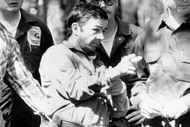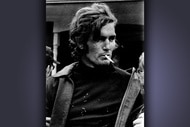Create a free profile to get unlimited access to exclusive videos, breaking news, sweepstakes, and more!
How Did Ted Bundy Escape From Authorities — Twice?
Serial killer Ted Bundy didn't go quietly after he was first captured by the law. Instead he orchestrated two truly wild prison escapes.
Prolific serial killer Ted Bundy proved himself to be a worthy adversary for law enforcement — not only did he evade capture for years, but he then escaped not just once, but twice from custody in outlandish schemes that seemed more like a work of fiction than reality.
Bundy’s first escape came in the summer of 1977 while he was awaiting trial on murder charges in Colorado. He had been extradited from Utah, where he was convicted on kidnapping charges, to stand trial for the murder of Caryn Campbell, a 23-year-old nurse who disappeared while on vacation at a Colorado ski resort.
Campbell walked down the hall of the Wildwood Inn at Snowmass on January 12, 1975 to retrieve a magazine from her hotel room and vanished, according to The Vail Daily. Her badly beaten body was later discovered a month later next to a dirt road, buried in the snow.
A warrant for Bundy’s arrest was issued on Oct. 21, 1976 after prosecutors said Bundy had been at the ski lodge the night of the murder. Gas receipts also placed him in the area at the time and her hairs were found his car, according to a 1978 article in The New York Times.
Bundy, a former law student, planned to defend himself in the first-degree murder trial and arranged for a series of privileges that would allow him to prepare for his defense. He was given his own telephone credit card which was reportedly paid for by the state, special health food, and had access to law books, the paper reported.
Bundy, who was seen by jailers as good-natured and charismatic, was also given access to the law library and was allowed to move about freely in court without his leg shackles.
That is, until one May day when Bundy was in the law library during a break from court, he leapt from a second story window of the Pitkin County courthouse, dropping 30 feet.
When the guard who had been standing outside the library’s door returned to the room to get him, Bundy was gone.
He was last seen running toward the Roaring Fork River that ran behind the courthouse, according to the Glenwood Post Independent, before disappearing.
The sleepy ski town soon became the hub of a massive manhunt to find the accused killer as road blocks were set up and law enforcement officers scoured the area.
“Since Bundy’s escape, parents have been asked to pick up their children at schools; the sale of guns and ammunition has been banned; people have been asked to travel in pairs and not go camping alone,” a June 9, 1977 article in the Glenwood Post read.
The guard on duty was suspended and the sheriff suddenly found himself under scrutiny about the privileges Bundy had managed to secure that ultimately had helped him escape, The New York Times reported in 1978.
But, Bundy’s charisma and charm had also worked its way into the town. A restaurant offered a “Bundyburger” special consisting of only a plain bun with a sign advertising it reading “Open it and see if the meat has fled.” One resident created a mock wanted poster listing Bundy as “Aspen’s foremost jumper and cross-country specialist;” others wore specially made T-shirts or shouted “Bundy Lives” into the air, media reports said.
The Aspen Times described it as a “circus-like” atmosphere.
“I don’t think anyone took him as seriously as they needed to. He was a dangerous, vicious person,” Ross Dolan told the paper in 2017.
Dolan would later snap an iconic image of the fugitive for the Glenwood Springs Post Independent after he’d been captured that showed Bundy sporting a devilish grin while he’s being led away in handcuffs.
While Bundy still on the lam, speculation in the media ran rampant, with newspapers at the time reporting that Bundy may have had an accomplice waiting to help him escape or that he’d fled to Wyoming, according to FBI archived files on Bundy that contained newspaper clippings from the time.
In reality, Bundy was still in the Aspen area and had been hiding in abandoned shacks and chalets on Smuggler Mountain, The New York Times reported.
He’d be found, tired and hungry, just days after his dramatic leap from the building.
The Pitkin County’s Sheriff’s Department hung a sign that read “Welcome Home, Teddy” to celebrate his return to captivity.
The escape cost him some of the privileges he’d once enjoyed and earned him a metal-plated cell in a maximum security prison in Glenwood Springs.
But, it wouldn’t be the last time Bundy would taste freedom.
Less than a year later, Bundy would escape from jail once again, this time embarking on a cross-country journey that had deadly consequences.
After his brief time on the run in the summer of 1977, Bundy complained that he was being held under inhumane conditions and began to lose weight from the poor prison meals.
He requested a change of venue for his trial away from Aspen, claiming the media attention he had received would make it impossible to get a fair trial, The New York Times reported.
The trial was transferred just before Christmas to Colorado Springs, which at the time had the highest number of men in the state sentenced to die in the gas chamber.
“My Christmas present from the court,” Bundy reportedly told a friend after hearing the news according to the 1978 article, “a guaranteed death sentence.”
But just before the new year, Bundy escaped the Garfield County jail by slipping through a one-foot square light fixture hole in his cell’s ceiling, The Glenwood Post Independent reported. He crawled through the hole, made his way through the plumbing and wiring in the ceiling and climbed into a closet connected to a jailer’s apartment, before fleeing.
The over 30 pounds of weight he previously lost had simply been a way for the notorious serial killer to once again slip through law enforcement’s grasp.
This time, Bundy headed out of town, stealing a car in Glenwood Springs, according to The Daily Vail.
When the car broke down, he hopped onto a bus, eventually making his way to Florida, where he’d reign more terror on an unsuspecting sorority house, killing two women and brutally beating two others. He'd then kidnap and murder a 12-year-old girl before the Pensacola Police Department re-arrested him in February 1978.
Bundy’s Houdini-like maneuvers would finally come to an end and the prolific serial killer would be put to death in 1989 for his crimes.
[Photo: Ross Dolan/Glenwood Springs Post Independent via Associated Press]





























